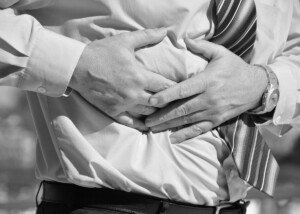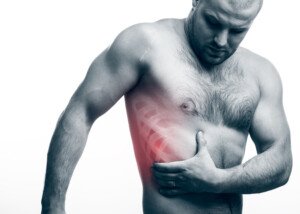
A doctor explains how gallstones cause pain…
Gallstone pain, or biliary colic, is often characterized by intense discomfort. The pain typically manifests in the upper right abdomen, just beneath the rib cage.
It may also radiate to the back or the right shoulder blade, sometimes causing referred pain in these areas.
The sensation is usually sharp or cramp-like and can be severe, coming in waves or episodes that may last from several minutes to a few hours.
“Biliary colic usually happens when the gallbladder contracts in response to a fatty meal,” says Akram Alashari, MD, a trauma surgeon at Geisinger Medical Center in PA, and author of “THE POWER OF PEAK STATE.”
“This compresses the stones, blocking the opening. As the gallbladder relaxes several hours after the meal, the pain subsides. In some people, the pain happens without having eaten anything.”
Pain from Gallstones Is Not a Singular Event
“Once you have a first attack of biliary colic, there is a good chance you will have more symptoms in the future,” continues Dr. Alashari.
“Such recurrent symptoms are usually more severe and occasionally associated with complications.
“A complication of gallstones that can be associated with sharp pain rather than dull pain is acute cholecystitis.
“Acute cholecystitis refers to inflammation of the gallbladder.
“This happens when there is a complete blockage of the gallbladder, caused by a gallstone.
“Unlike biliary colic, which resolves within a few hours, pain is constant with acute cholecystitis and fever is common.”
Severe nausea, and jaundice (yellowing of the skin) may also come with cholecystitis.
More on Gallstone Pain
Gallstones can be the size of a grain of sand to that of a ping pong ball. You may have one or several at the same time.
The pain isn’t always on the upper right abdomen. It can also be in the upper central abdomen.
The pain may also be between your shoulder blades or in your right shoulder.
There may be nausea or vomiting if the pain has been triggered by a large fatty or greasy meal.
Episodes of the pain can vary, coming and going intermittently.
Risk Factors for Developing Gallstones
• Being female
• Being over the age of 40
• Being overweight
• Fast weight loss
• A sedentary lifestyle
• Pregnancy
• A diet high in fats and “bad” cholesterol
• A diet low in fiber
• Diabetes
• Liver disease
• Hormone replacement therapy or oral birth control pills
• Native American or Hispanic
• Family history of gallstones
As you can see, some of these risk factors are modifiable.
You should get to work at making the lifestyle changes that will lower your risk of getting a gallstone for the first time or for a repeat time.

Dr. Alashari was formerly with Grand Strand Regional Medical Center in SC as an abdominal and critical care surgeon.
 Lorra Garrick has been covering medical, fitness and cybersecurity topics for many years, having written thousands of articles for print magazines and websites, including as a ghostwriter. She’s also a former ACE-certified personal trainer.
Lorra Garrick has been covering medical, fitness and cybersecurity topics for many years, having written thousands of articles for print magazines and websites, including as a ghostwriter. She’s also a former ACE-certified personal trainer.
.









































